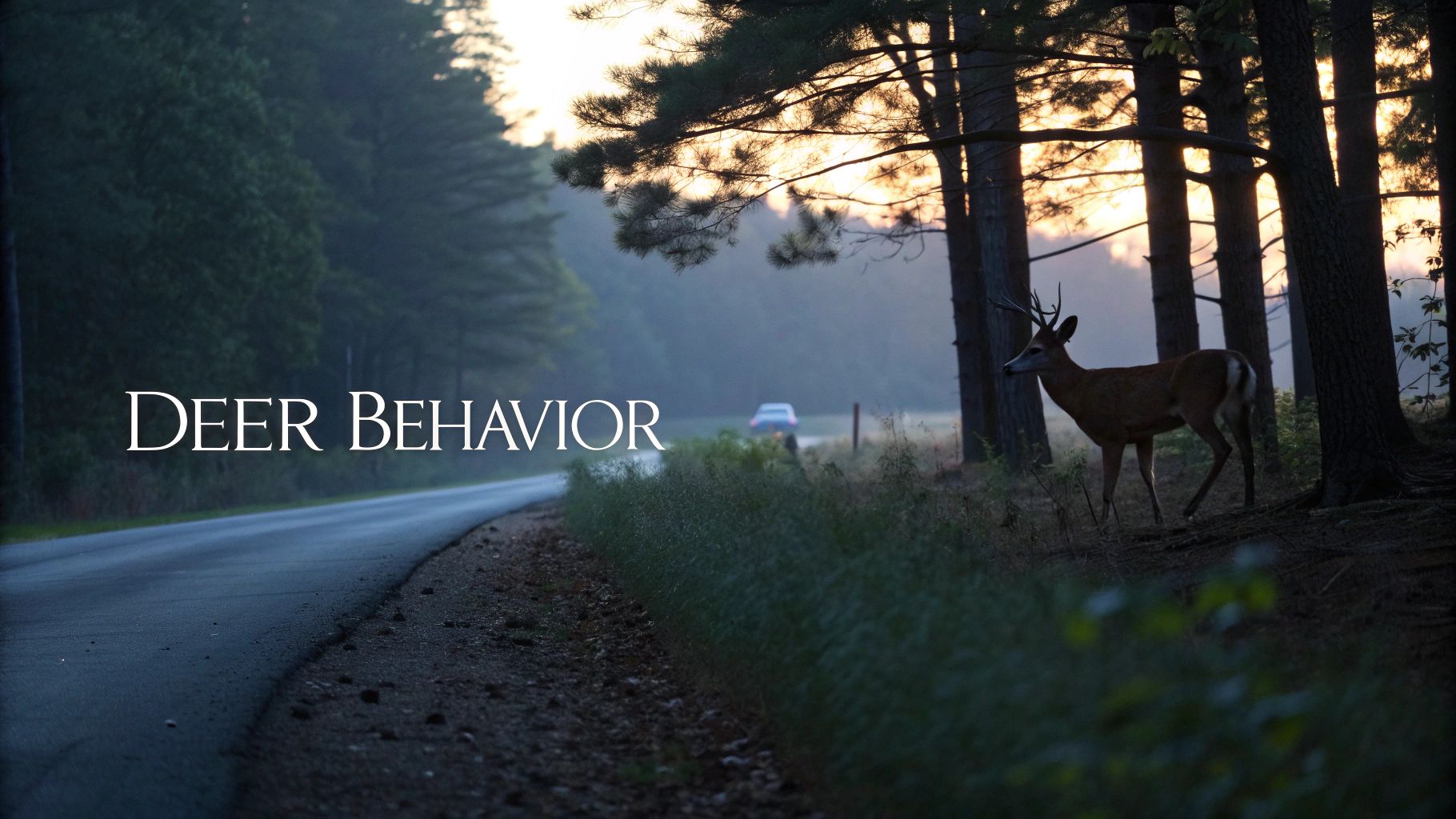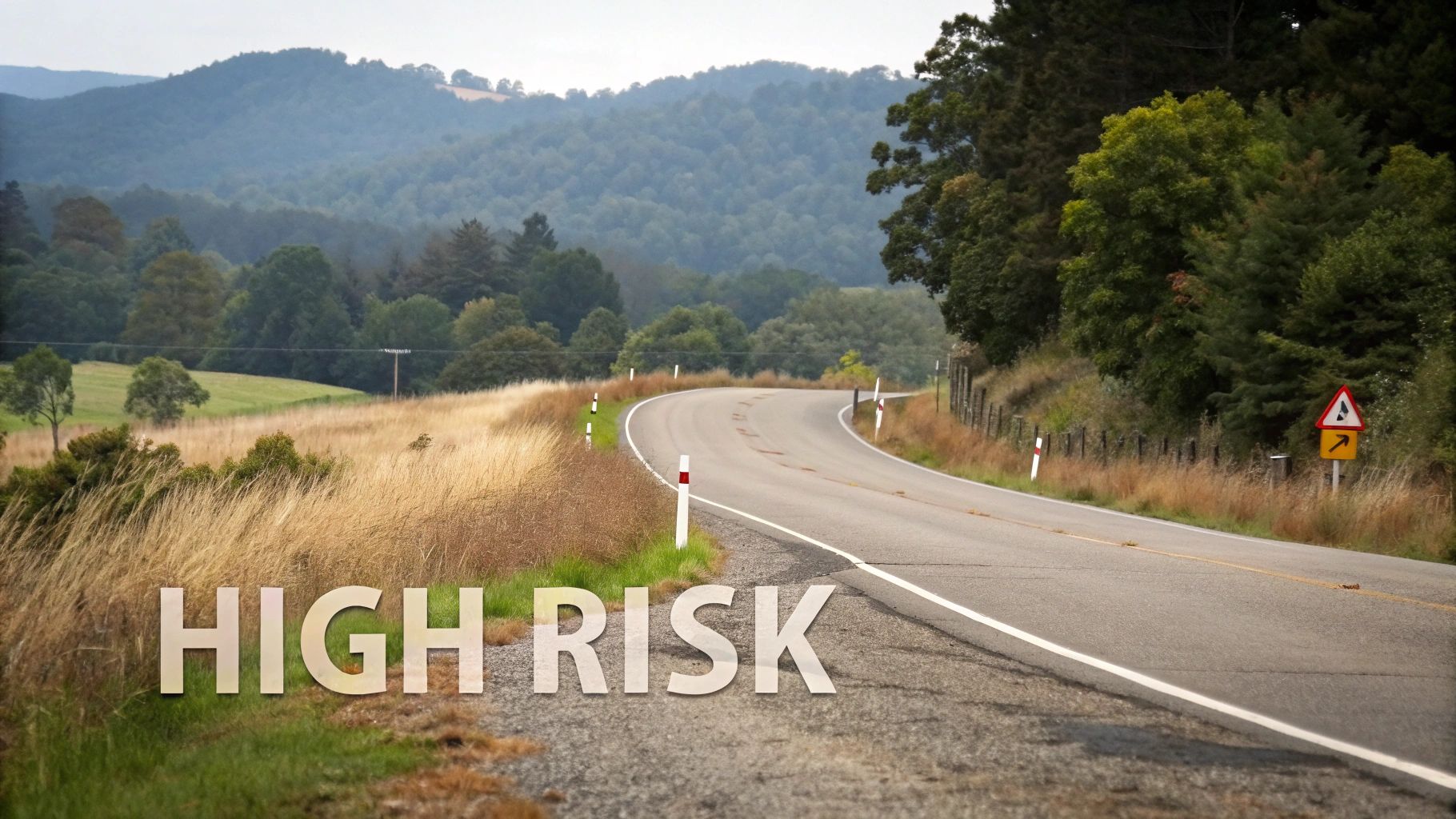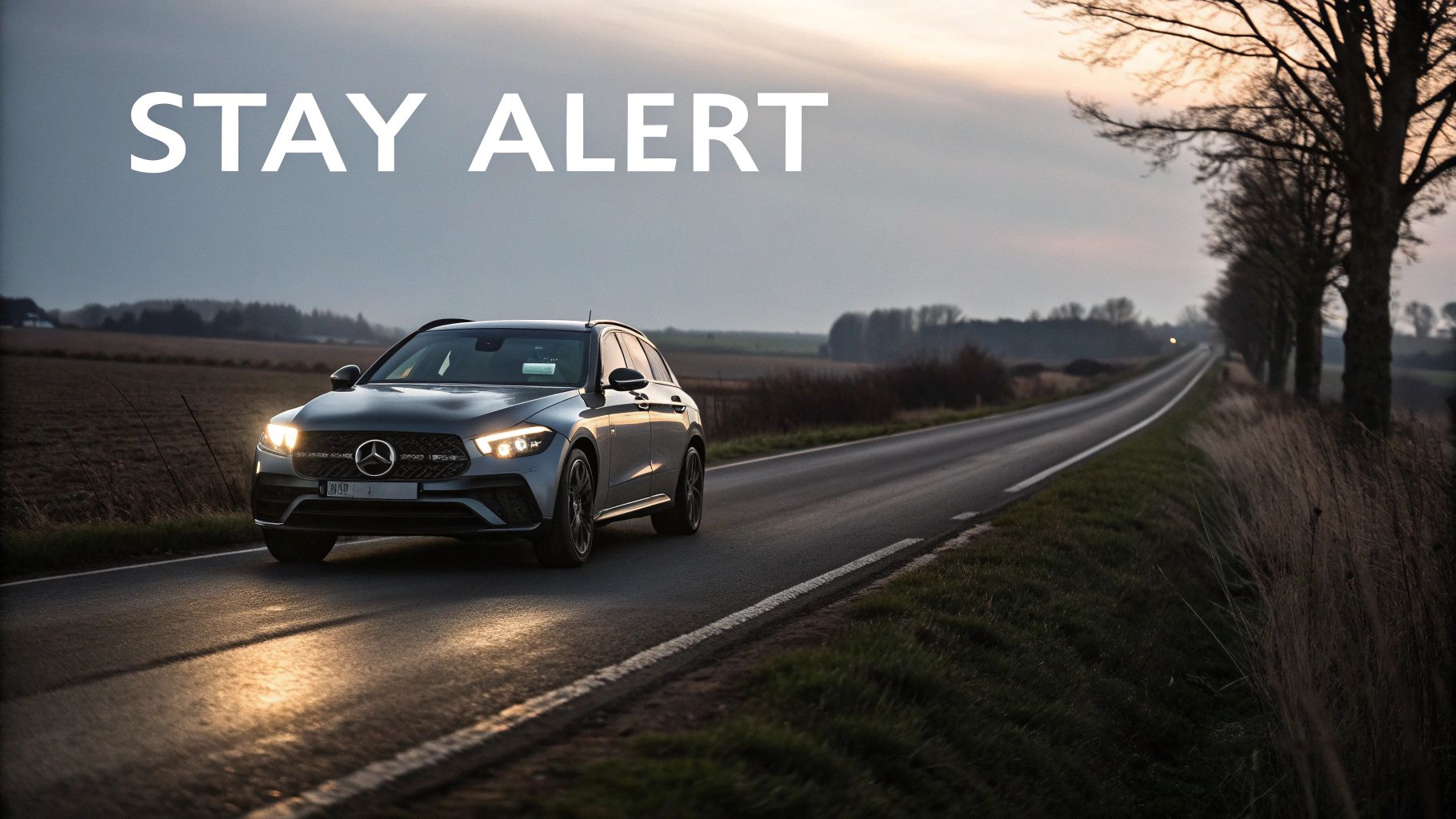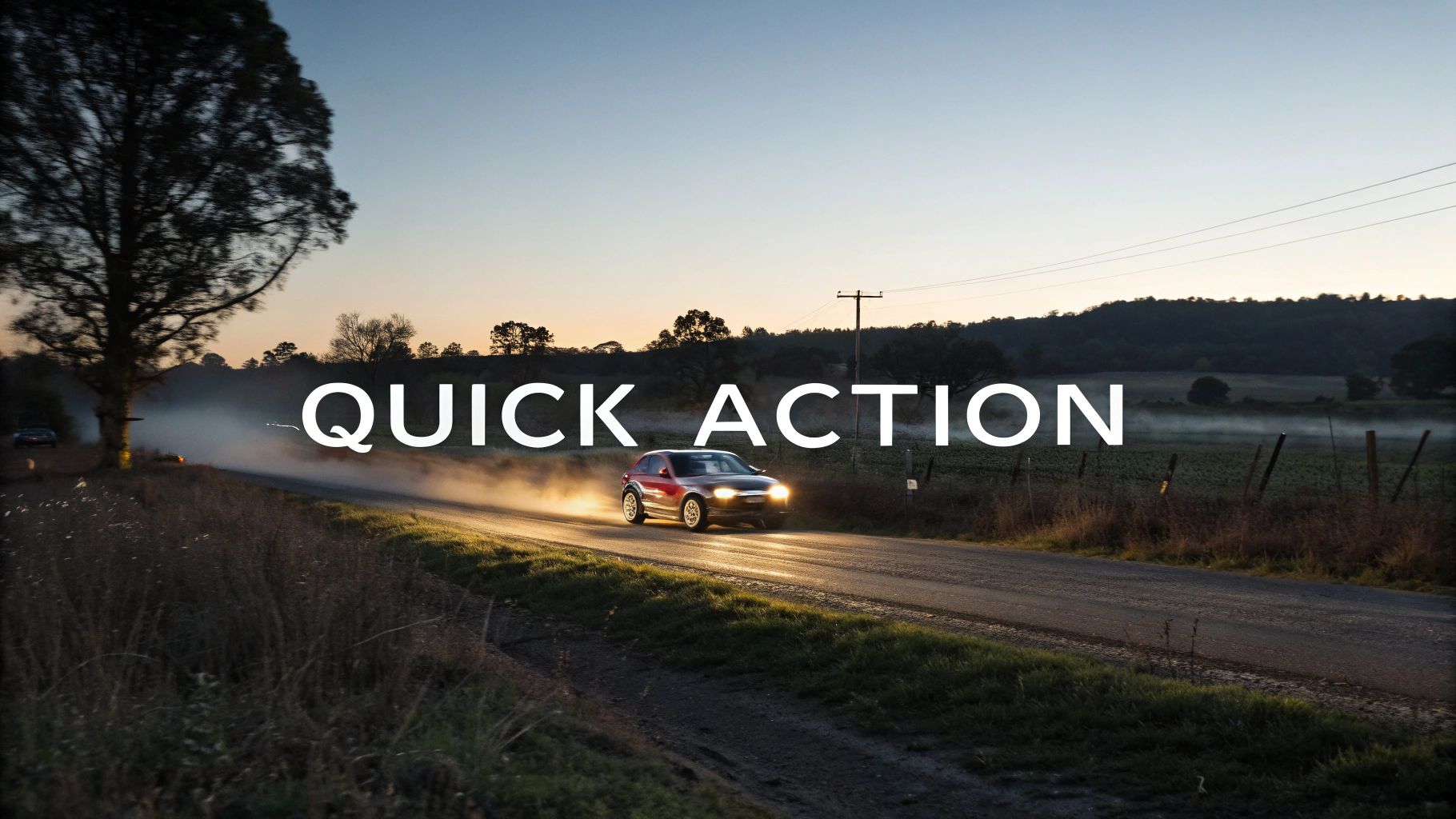Understanding Deer Behavior: The Science of Prevention

To avoid deer collisions, we need to understand why deer behave unpredictably on roadways. This knowledge is the basis of proactive prevention. Deer don't follow traffic laws; instinct and environmental cues guide their movements. Anticipating their actions requires understanding their motivations.
Seasonal Influences: Migration and Mating
Seasonal behavior is a critical factor. Deer migrate and mate annually, impacting their roadway interactions. During the fall rut, breeding is their primary focus, often leading them to cross roads regardless of traffic. This increased activity isn't limited to rural areas; it also affects suburban environments.
Understanding the timing and location of deer-vehicle collisions is crucial. In the United States, these collisions peak from October through December, coinciding with deer migration and mating season. This period sees increased deer movement, raising the collision risk on highways and in suburban areas. In 2021, there were 164 deaths from animal collisions, mainly during this peak season.
States like Pennsylvania and West Virginia experience high rates of deer-vehicle collisions due to their large deer populations and extensive road systems. For more information, see Car and Deer Collisions Cause 200 Deaths, Cost $4 Billion a Year. This highlights the importance of increased vigilance during these months.
Daily Rhythms and Environmental Factors
Deer are most active at dawn and dusk. This coincides with reduced visibility for drivers, creating a dangerous situation. Environmental factors like food availability and weather also influence deer movement. Heavy snow, for example, can drive deer closer to roads in search of food, increasing the chance of vehicle encounters.
Deer Perception and Instinctive Responses
Deer perceive the world differently than humans. They don't see vehicles as threats the same way we do. Their vision is designed to detect movement and light changes, not to judge the speed and distance of approaching cars. A deer's "flight" response can be triggered suddenly, leading to dangerous, last-second road crossings.
The "freezing" response further complicates matters. Overwhelmed by headlights, a deer might freeze in a vehicle's path. Understanding these perceptual limitations and instinctive behaviors is crucial for drivers. By anticipating these reactions, you can significantly improve your ability to react safely.
High-Risk Seasons: When Deer Are Most Active

Understanding deer behavior is crucial for preventing collisions. Timing also plays a vital role. Certain times of the year bring significantly higher risks. This is especially true during the fall rut, or mating season. Bucks become less cautious, focusing on finding mates. This often leads to a spike in deer-vehicle accidents.
The Fall Rut: A Time of Heightened Risk
The fall rut typically lasts from October through December, peaking in November. Deer activity increases dramatically during this period, especially at dawn and dusk. This coincides with reduced visibility for drivers, a dangerous combination. You might also be interested in learning more about health insurance options: Comparing 2025’s Best Health Insurance Plans for Families – What You Need to Know.
Insurance claims and wildlife tracking studies confirm the increased risk. For instance, deer-related crashes in Virginia rose by 20% between 2022 and 2023. The majority of these accidents occurred during the fall. This data highlights the importance of increased vigilance during these months.
Dawn and Dusk: Peak Danger Periods
Dawn and dusk are high-risk periods year-round, even outside the rut. These are the times when deer are most active, moving between feeding and bedding areas. The combination of low light and increased deer movement creates hazardous driving conditions.
Seasonal Variations in Deer Activity
Deer activity fluctuates throughout the year. Understanding these changes is key to preventing accidents. The following table provides a monthly breakdown of deer collision risk levels, deer activity, and driving recommendations.
To help drivers better understand these risks, we've compiled the information below:
| Month | Risk Level | Deer Activity | Driving Recommendations |
|---|---|---|---|
| Spring | Moderate | Increased movement, especially fawns | Be cautious near wooded areas and fields |
| Summer | Moderate | Active, particularly at dawn and dusk | Maintain safe speeds and scan roadsides |
| Fall (Rut) | High | Peak activity, mating season | Extreme caution, reduce speed, use high beams |
| Winter | Moderate | Reduced activity, seeking food sources | Watch for deer near roadsides and fields |
As you can see, adjusting your driving habits to the season is crucial for safety. By understanding these high-risk seasons and times of day, you can take proactive steps to avoid deer collisions.
Danger Zones: Identifying High-Risk Road Environments

Not all roads pose the same threat when it comes to deer collisions. This section explains how to identify these high-risk locations before you even spot a deer. Recognizing these danger zones is crucial for safe driving.
Landscape Features That Indicate Risk
Certain landscape characteristics strongly suggest potential deer crossings. Forest edges and agricultural boundaries are prime examples. These areas provide both food and shelter, making them appealing crossing points for deer. Similarly, stream crossings serve as natural pathways for deer movement.
Suburban interfaces, where developed areas meet natural habitats, represent another high-risk area. Deer are often compelled to cross roads in these zones as they move through fragmented landscapes. This is especially important to keep in mind in rapidly developing areas.
The Role of Habitat Fragmentation
Habitat fragmentation and road placement are key factors in understanding deer-vehicle collisions. As human development encroaches on natural habitats, roads and highways become both barriers and attractants for deer, increasing the risk of collisions. This is particularly noticeable where roads cut through forests and other wildlife areas, creating zones with high deer activity.
For instance, in the US, the expansion of roadways combined with habitat fragmentation has led to a significant increase in deer-vehicle collisions. In Europe, regions with dense road networks, like parts of Scotland, experience more frequent collisions, even without the highest deer populations. You can explore this topic further here.
Roadside Indicators and Topography Awareness
Even subtle roadside cues can indicate potential deer crossings. Experienced drivers often watch for well-worn paths near the road, suggesting regular deer movement. Changes in vegetation, such as browsed bushes or flattened grass, can also be revealing. These seemingly minor details offer valuable insights.
Topography also plays a significant role. Dips and valleys where visibility is reduced can be especially hazardous, as deer might be hidden until the last second. Likewise, curves in the road can obscure approaching deer, shortening your reaction time. Understanding the terrain helps anticipate these potential crossing areas.
Recognizing High-Activity Stretches
Some road sections seem to attract more deer than others. These high-activity areas often correspond with the landscape features and roadside indicators previously discussed. Observing these patterns on your regular routes is essential.
For example, if you frequently see deer near a specific curve or intersection, treat that spot as a danger zone. This awareness lets you adjust your speed and heighten your vigilance in those particular locations, fostering safer driving habits. Being mindful of these patterns can significantly decrease your collision risk.
Defensive Driving Tactics That Actually Save Lives

Knowing where deer are likely to cross is important. However, how you drive in those areas is even more critical. This section explores proven defensive driving techniques to minimize deer collision risks. These strategies go beyond basic alertness and delve into the physics and psychology of effective prevention. Securing your vehicle and driving defensively are key, as is anticipating potential hazards. You can read more about sliding glass door protection as an example of proactive safety measures.
Speed Management and Visual Scanning
Speed management is your first line of defense. Reducing your speed, especially during dawn and dusk, drastically improves reaction time. This provides those crucial extra seconds needed to respond if a deer suddenly appears. At slower speeds, braking effectively can be the difference between a near miss and a collision.
Visual scanning is equally important. Actively scan the roadside and beyond, using your peripheral vision. This wider perspective can help you detect movement earlier. Constantly scanning for "eye shine" in your headlights can also alert you to deer before they are fully visible.
Headlight Usage and Avoiding Swerving
Using your high beams whenever safe in low-light conditions significantly improves visibility. High beams illuminate a deer's eyes from a much greater distance, providing more reaction time. Remember to dim your lights for oncoming traffic.
The natural instinct to swerve is often the wrong reaction. Swerving can lead to a loss of control. This can cause your vehicle to veer into oncoming traffic or off the road entirely, potentially causing more serious accidents than hitting the deer. Instead, focus on controlled braking and maintaining a straight path, even during an imminent collision.
Handling Multiple Deer and Split-Second Decisions
Deer rarely travel alone. If you see one deer, expect more. Slow down immediately and anticipate that other deer may be crossing. This preparedness can help prevent a chain reaction of dangerous maneuvers.
To further illustrate best practices, let's examine a comparison of recommended actions and those to avoid:
Deer Collision Prevention: Do's and Don'ts
| Situation | Recommended Action | Actions to Avoid | Reasoning |
|---|---|---|---|
| Seeing a deer | Brake firmly, stay straight | Swerving | Maintaining control is crucial; swerving can cause more serious accidents |
| Low light | Use high beams (when safe) | Driving distracted | Increased visibility allows for earlier detection and reaction |
| Deer crossing | Slow down, anticipate more deer | Speeding | Deer often travel in groups, and slowing down gives you time to react |
| After a collision | Pull over, report to authorities | Leaving the scene | Ensure safety and follow legal procedures |
Analyzing real collision scenarios highlights the value of these defensive driving tactics. In many instances, the difference between a near miss and a serious accident hinges on split-second decisions based on sound driving practices.
Vehicle Technology: What Actually Works
Modern vehicles offer an array of technologies designed to reduce the risk of deer collisions. But how effective are they? This section examines various technologies, from routine maintenance to advanced systems, separating the truly effective from those with less substantial evidence.
The Importance of Basic Maintenance
Before delving into advanced technology, it's crucial to remember the fundamental role of proper vehicle maintenance. Well-maintained brakes are vital for quick stops in emergency situations. Equally important are properly aligned and functioning headlights. These maximize visibility, particularly during dawn and dusk when deer are most active. These basic, yet crucial, elements significantly improve your ability to react to unexpected hazards on the road.
Debunking the Myths: Deer Whistles and Other Aftermarket Devices
The market is flooded with aftermarket products claiming to deter deer, including deer whistles. These devices emit ultrasonic sounds, purportedly irritating to deer. However, numerous studies have demonstrated limited effectiveness of these devices in real-world driving situations. This underscores the importance of prioritizing proven preventative measures. Effective collision avoidance relies more heavily on driver behavior and advanced vehicle technology.
Advanced Driver-Assistance Systems (ADAS): Game Changers
Modern ADAS features play an increasingly significant role in preventing deer collisions. Automatic Emergency Braking (AEB) systems, for instance, can automatically engage the brakes if a collision is imminent. This can lessen the severity of an impact, or even prevent it altogether. These systems utilize sensors to detect obstacles, providing an additional layer of safety.
Thermal imaging, an increasingly available feature on some vehicles, detects the heat signatures of deer, even in darkness or fog. This technology substantially improves visibility, giving drivers valuable reaction time. These features, combined with continuous advancements in vehicle technology, are steadily improving driver safety and reducing accident rates.
The Role of Lighting Technology
Beyond basic headlight maintenance, advancements in lighting technology contribute to safer driving conditions. Adaptive headlights, which swivel with the steering wheel, improve visibility around curves. High-intensity discharge (HID) or LED headlights offer brighter, more extensive illumination. This enhanced vision reduces the chances of encountering deer unexpectedly, enabling more proactive driver responses. For post-collision vehicle protection, explore our guide on Expert Picks: The Best Car Insurance Companies for 2025.
Practical Guidance for Various Vehicle Types
Optimal collision avoidance strategies often depend on the type of vehicle being driven. Larger SUVs and trucks, for example, provide a higher driving position, potentially improving visibility. However, these vehicles also require longer stopping distances, necessitating careful speed management. This emphasizes the importance of adapting driving habits to the specific characteristics of each vehicle type. Understanding these nuances is essential for maximizing safety on the road.
Beyond the Driver: Infrastructure That Prevents Collisions
While attentive driving is paramount, strategic infrastructure also plays a vital role in minimizing deer collisions. This section explores innovative systems implemented in high-risk areas, moving beyond individual responsibility to community-wide solutions. These include wildlife crossings, exclusion fencing, and advanced warning systems.
Wildlife Crossings and Fencing: Creating Safe Passage
Wildlife crossings, such as overpasses and underpasses, offer designated areas for animals to safely cross roads. These structures are often landscaped with vegetation to mimic natural surroundings, effectively guiding deer and other wildlife away from traffic. Coupled with exclusion fencing, which prevents animals from accessing the roadway except at the crossings, these systems create secure corridors for safe passage. This significantly reduces the chances of animals wandering onto roads and into the path of oncoming vehicles.
Dynamic Warning Systems: Real-Time Detection
Traditional deer crossing signs provide a static warning. Dynamic warning systems, however, offer a more proactive approach. These systems utilize sensors, like infrared beams or radar, to detect animal presence in real time. When an animal is detected, flashing lights or other alerts are activated, warning drivers of potential hazards. This immediate notification provides drivers with crucial seconds to react, significantly lowering the risk of a collision.
Community-Based Strategies and Citizen Science
Community involvement is key to successful deer collision prevention. Citizen science initiatives, where community members report deer sightings and collisions, provide invaluable data. This data helps map high-risk locations, informing infrastructure planning and public awareness campaigns. For example, programs encouraging residents to report deer sightings via mobile apps deliver real-time data that can identify areas needing immediate attention.
Research and preventative measures are crucial to reducing deer-vehicle collisions. Studies show that interventions such as wildlife warning signs, acoustic devices, and wildlife fences can be effective. However, the effectiveness of these measures can differ. Continued research is needed to find the most impactful strategies. More detailed statistics can be found here.
Case Studies: Success Stories in Collision Reduction
Many communities have witnessed significant reductions in deer collisions through multifaceted approaches. For example, some municipalities have installed wildlife crossings and fencing along high-risk roadways, leading to considerable decreases in collision rates. These successes highlight the effectiveness of combining infrastructure improvements with community engagement. You may also be interested in: The Ultimate Guide to Choosing the Right Home Insurance Policy in 2025. By studying these successful programs, other communities can adapt similar strategies for their specific needs.
Emerging Technologies: Shaping Roadway Design
Emerging technologies are reshaping roadway design for enhanced safety. Smart roadways equipped with sensors and communication systems can detect and alert drivers to the presence of animals. Vehicle-to-infrastructure (V2I) technology enables direct communication between vehicles and roadside infrastructure, further improving driver awareness. These advancements offer promising solutions for minimizing wildlife-vehicle conflicts. This interconnected system promotes safer road sharing by improving driver awareness.
Comments are closed.